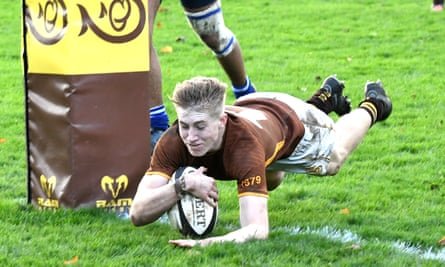[ad_1]
In a setting whose gasp-inducing beauty would be hard to beat in world sport, hundreds of pupils switch from their green tweed blazers to sports kits to spend four afternoons a week having rugby, football, netball and hockey lessons. But mainly rugby. For this is Sedbergh, one of the best sporting schools in England, where rugby is king.
On their sacred pitches, which have stunning views of Howgill Fells and sit beside their stylish indoor sports centre, 40 sixth formers split into forwards and backs to train. The facilities would be the envy of several professional clubs.
You do not need to have been to Sedbergh to know what it looks like. Think of the school campus in Dead Poets Society or Catcher in the Rye. Sedbergh, which sits between the Yorkshire Dales and the Lake District, brands itself “England’s book town”. But the school’s manicured pitches lie among lush tufty fields that encroach on the town centre and a dozen sets of towering white posts poke up among the grey rooftops as if to declare: “This is rugby town.”
Dozens of professional rugby players are created in this rural paradise. The productivity of Sedbergh School Football Club – formed in 1879 and known as The Brown for their distinctive kit – would stand alongside any academies at the world’s biggest clubs in any code. Simon Mulholland, who is in his 11th season as the school’s director of rugby, thinks they are “if not top, then pretty close” to being the school that produces the most professional players. “The full boarding helps as they are living and breathing rugby 24/7 here. I’m confident you couldn’t walk across the school without seeing a game of touch somewhere. It’s in the air. It’s a pretty special place.”
Thriving in the professional era, they have old boys spread across Europe’s top leagues, with Old Sedberghians representing England (Bevan Rodd), Scotland (Cam Redpath), Wales (Jim Botham) and Ireland in the past year.

Eighty miles across the old West Riding is Castleford, a town as socially, culturally and aesthetically different as any county can muster – yet it is also home to another of the nation’s finest centres of rugby excellence. Sedbergh’s status as England’s most successful rugby school is challenged by Castleford Academy’s haul of silverware. The state comprehensive, judged “outstanding” by Ofsted, has won a third of all the RFL’s Champion Schools competitions, a staggering 53 titles.
At both of these Yorkshire schools, students spend their first days playing rugby. They start as they mean to go on. The big difference is that most Sedbergh students are paying £40,000 a year to board. “The majority of boys come to Sedbergh for rugby,” says Mulholland, who grew up in New Zealand and was recently crowned coach of the decade by NextGenXV.
“We’ve only got 380 boys so it’s not huge but, where other schools are having fewer boys wanting to play rugby, our numbers are going the other way. We’re having to create fixtures for them. The whole school timetable is organised around sport. In winter, we have games in the middle of the day, then lessons from 4pm to 6pm after it’s dark.”
With five on-field sessions a week, plus analysis, and strength and conditioning work, Sedbergh is effectively an elite full-time academy. Mulholland estimates around 30 of his sixth formers are with Premiership academies. “Sale, Newcastle and Yorkshire are our biggest feeders, but we have kids at Saracens, Cardiff, Edinburgh – and a couple at rugby league clubs. We have really good communication with the clubs to manage their workloads. From September to December, their priority is school. So a pupil might go twice a month to Sale or Newcastle, then after Christmas at least once a week, and even more after that if they don’t play sevens or 10s for us. The tricky bit is when they get to international standard, where there are always clashes.”

In contrast, Cas Academy has players at five Super League academies, but their school teams only train for one hour a week, with no analysis or gym programmes. “Lads who are on scholarships at pro clubs can go into the fitness suite to do it themselves,” explains PE teacher Danny Holmes, who played for the school in three national finals and has gone on to coach them to over a dozen more. “Some are training twice a week with their community clubs and twice with their pro club, so even once with us might be too much,” he says.
The school opened in 1906 and, while the sculptor Henry Moore remains its most famous former pupil, David Stephens and Alan Rhodes became league stars even though it was a grammar school at the time that only played union. Recent alumni have appeared for every English Super League club, including the Leeds Rhinos captain Cameron Smith, the former Brisbane Broncos back Greg Eden, and Hollie-Mae Dodd of the Canberra Raiders – who won the Champion Schools title for four years running.
Although Sedbergh offers some scholarships and bursaries to promising young players whose parents cannot afford the hefty fees, the majority pay for an extraordinary experience that includes weekly trips to away games around the country and an overseas tour in sixth form. Five of the school’s 12 teams are for sixth-form pupils. “The first team gets national exposure,” says Mulholland, whose brother-in-law is the new All Blacks coach Scott Robertson. “Because we have to travel so much, we spend a lot of time together. It’s a family environment and the players are so proud to wear ‘the Brown armour’ as we call it.”
In contrast, Cas Academy does not have a team for sixth formers as most of their students leave for college at 16. Unlike Sedbergh, the school cannot cast its net wide for rugby talent. “Our catchment area has got smaller, so kids can’t really choose to come here for rugby,” explains Holmes, who coached five teams last year while Lacey Owen, who plays for the Women’s Super League champions York Valkyrie, led her girl’s team to national glory. “We set tough expectations on kids and rugby can get pupils back onside – it does have an impact,” adds Holmes. “But we’re not an elite school for rugby performance.” Well, not deliberately anyway.

While Sedbergh remains a union citadel, it has plenty of connections to league. Mulholland calls himself “a big NRL fan”; Keighley Cougars halfback Charlie Graham was signed by Hull FC after starring for Sedbergh at sevens; and a number of former league pros have sent their children to play for The Brown. On the honours board in the Wavell Wakefield Pavilion – named after former pupil and fierce defender of amateurism while he was RFU president – are the names of every international player the school has produced. After Will Carling, Will Greenwood and James Simpson-Daniel comes Ewan Dowes, who made seven appearances for the England rugby league team. The Challenge Cup winner remains a regular at old boys’ events.
So, given their reputation for exciting rugby, how would Sedbergh fare if they entered the 13-a-side competitions? “Good question,” says Mulholland with a smile. “We throw it around, so I think our style and overall skillset would suit us pretty well. We’d go OK in attack and the physicality would be a brilliant challenge.”
These two towns in West Riding have another key difference. While rugby is at the very heart of school life at Sedbergh – boys train in the school’s gym at night while others hurl Hail Marys across the playground, challenging each other to catch them in the dark – the town has no rugby club. In Castleford, rugby league is engrained in the fabric of a community immersed in league. The sport is an identifier, a symbol of civic pride.
“I’m asked a lot why we are so successful,” reflects Holmes. “As a Cas lad and a former pupil, I honestly think it’s just the culture. Kids here live and breathe it from such a young age. You only have to walk down to Cas Tigers and half the school are there with their parents. You’ve got a rugby ball in your hands from a young age. When they start here it’s already embedded in them. They’re primed and ready for it.
“They love playing rugby. Getting to finals is magical: it puts smiles on faces and you can see the pride they have in the school. Everyone wants to be a part of it. I get knocks on the door: ‘Are we training, sir?’ From 3pm to 4pm every day, it’s extra-curricular time and that means rugby for many.” For others, it’s dance or drama; Cas Academy has performed at the National Theatre.
At a time when the majority of 15-year-olds say they dislike school and a third of them are persistently absent, schools as different as Sedbergh and Cas Academy are giving pupils a platform to rugby excellence – and offering them extraordinary opportunities.
Follow No Helmets Required on Twitter and Facebook
[ad_2]
Source link

